
The former Hospital de la Santa Creu i Sant Pau in the neighborhood of El Guinardó, Barcelona, Catalonia, Spain, is a complex built between 1901 and 1930, designed by the Catalan modernisme architect Lluís Domènech i Montaner. Together with Palau de la Música Catalana, it is a UNESCO World Heritage Site.
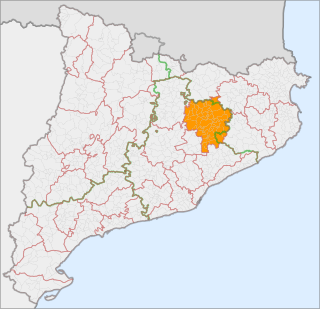
Osona is a comarca situated in central Catalonia, Spain. Its capital is Vic. Its population in 2001 was 129,543. Osona covers roughly the same area as the historic Catalan county of Osona. The name Osona comes from Ausetans, a group of Iberian people who had their capital in Ausa ; the Romans called the area Ausone or Ausona. While most of the comarca is within the province of Barcelona, the municipalities of Espinelves, Vidrà and Viladrau form part of the province of Girona.
The Archaeology Museum of Catalonia was created under the Museums of Catalonia Act in 1990 by the Department of Culture of the Government of Catalonia.

Berenguer de Cruïlles was bishop of Girona, (Catalonia), (1349–1362) and first President of the Generalitat de Catalunya (1359–1362) in the 14th century, nominated by the Corts de Cervera in 1359.

La Bisbal d'Empordà is the county seat of the comarca of Baix Empordà in Catalonia, Spain. The town lies 29 km southeast of Girona, 12 km west of Palafrugell and 19 km northwest of Palamós along road C-66 from Girona to Palafrugell/Palamós, where it becomes C-31. Two other roads branch off at La Bisbal, GI-660 to Calonge and Sant Feliu de Guíxols and GI-664 to Cassà de la Selva; both roads cross the hilly coastal range called the Gavarres, with many twists and turns. The municipality lies on the northern edge of the Gavarres, on either side of the Daró river-bed, a dry tributary of River Ter.

Maçanet de la Selva is a Spanish municipality in the province of Girona, situated in the comarca of the Selva, Catalonia. It is an important communications junction, where the routes from the coast meet those from the Prelittoral Depression to form a single axis north towards Girona and the French border. RENFE railway lines run both south-east towards Blanes and the coasts of the Maresme and south-west towards Granollers: the station is shared with the neighbouring municipality of Massanes.

Riudellots de la Selva is a municipality in the comarca of the Selva in Catalonia, Spain. It is situated in the basin of the Onyar river, on the A-7 autopista and the main N-II road, and is served by a RENFE railway station on the line between Barcelona and Girona and the GE-672 road and is close to the aeroport of Girona.

C-25 or Eix Transversal is a 280 km long primary highway in Catalonia, Spain. It crosses the Catalan Transversal Range mountainous region, communicating the northern end of the Catalan Coastal Depression with the Catalan Central Depression.

The Maristes Valldemia school, is located in Mataró, Province of Barcelona - Catalonia (Spain). It is a catholic school run by Marist Brothers, and dedicated to Our Lady the Virgin of the Candle. The ownership is held by Fundació Champagnat, Fundació Privada.

The Barcelona–Vallès Line is an unconnected standard gauge railway line linking Barcelona with Sabadell and Terrassa via the Collserola mountain range, in Catalonia, Spain. Its name refers to the Catalan historical region of Vallès, whereby most part of the line runs. Plaça de Catalunya station serves as the Barcelona terminus of the line, where almost all its trains either start or terminate. The line then continues northwards and branches off twice before leaving the city limits. Its main route splits in two in Sant Cugat del Vallès, forming two major branches to Sabadell and Terrassa. It has 40 passenger stations in operation and a total line length of 48.1 kilometres (29.9 mi).

Barcelona El Clot-Aragó is a Rodalies de Catalunya station in El Camp de l'Arpa del Clot, in the Sant Martí district of Barcelona in Catalonia, Spain. It is served by Barcelona commuter rail service lines R1, R2 and R2 Nord, as well as Girona commuter rail service line RG1 and regional line R11. Passengers can commute here to Barcelona Metro station Clot. Like its metro counterpart, the station is completely underground, under Carrer d'Aragó and Avinguda Meridiana.

The R1 is a line of Rodalies de Catalunya's Barcelona commuter rail service, operated by Renfe Operadora. It runs northwards from the Barcelona area to the southern limits of the province of Girona, passing through the coastal Maresme region. Since 2014, some services have been extended further north towards Portbou, near the French border. These services are designated RG1 and are considered part of the Girona commuter rail service. The line had an annual ridership of 28 million in 2016, achieving an average weekday ridership of 102,214 according to 2008 data.

Rodalies de Catalunya is the main commuter and regional rail system in the Spanish autonomous community of Catalonia. It is administered by the Government of Catalonia and operated by the national rail operator Renfe Operadora. The system consists of 17 service lines chiefly centered in the Barcelona area, serving a total of 203 stations throughout Catalonia, with an average number of 1,000 trains running on it every day. In 2016, it had an annual ridership of 117 million.

Sant Aniol de Finestres is a municipality in the comarca of Garrotxa in Girona, Catalonia, Spain.

Domènec Fita i Molat is a Spanish artist.
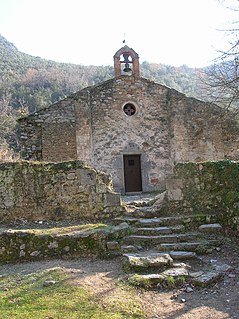
Sant Aniol d'Aguja is a Benedictine monastery in Montagut i Oix, Province of Girona, Catalonia, Spain. It was declared a Bé Cultural d'Interès Nacional in 1983.
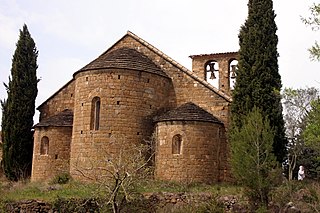
Sant Sepulcre de Palera is a Benedictine monastery in Beuda, in the comarca of Garrotxa, Province of Girona, Catalonia, Spain. The priory was consecrated by Bishop Berengar of Berga in 1085, with the assistance of the bishops of Barcelona, Carcassonne, Albi and Elne. In 1107 it became part of the monastery of Santa Maria de la Grasse until the sixteenth century, when it became a pilgrimage centre known as Santo Domingo de Palera. In 1936 the temple was desecrated and several figures and parts of altarpieces disappeared. It became a Bien de Interés Cultural site on 24 September 1964.

St Martin's Church (Catalan: Sant Martí de Puig-reig is a Romanesque church from 12th century in Puig-reig, Spain, near the modern parochial church and the former Puig-reig Castle.
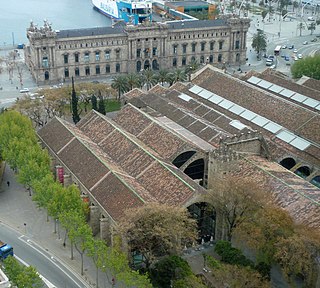
The Maritime Museum of Barcelona (MMB) is located in the building of Drassanes Reials de Barcelona , the royal arsenal of Barcelona, dedicated to shipbuilding between the thirteenth century and eighteenth century. The first mention of these arsenals date from 1243 in a document indicating the boundaries of the city of Barcelona where it mentions its shipyard.
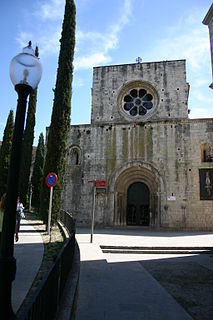
The Girona headquarters of the Archaeology Museum of Catalonia contains materials found during archaeological excavations at various sites in the province of Girona, dating from prehistory to the Middle Ages. The museum was founded as the Provincial Museum of Antiquities and Fine Arts in 1846 by the Provincial Monument Commission, and is therefore one of the oldest museums in Catalonia. Between 1846 and 1857 the Museum had several different locations, until Sant Pere de Galligants monastery in 1857, where it has remained until today, and where it was given the name by which it is popularly known.






















